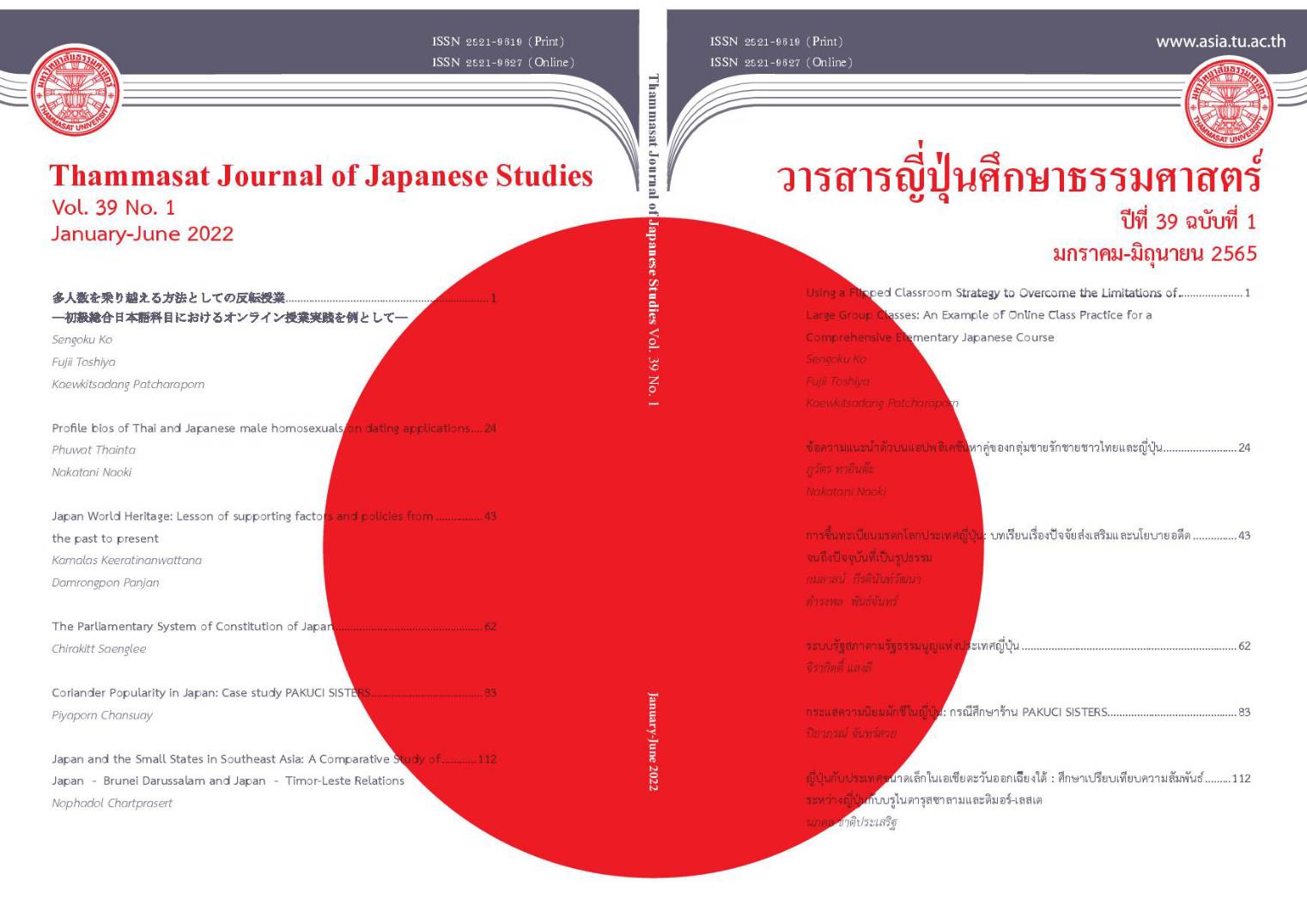การขึ้นทะเบียนมรดกโลกประเทศญี่ปุ่น: บทเรียนเรื่องปัจจัยส่งเสริมและ นโยบายอดีตจนถึงปัจจุบันที่เป็นรูปธรรม
คำสำคัญ:
มรดกโลก, สมบัติชาติ, การท่องเที่ยว, การอนุรักษ์สมบัติชาติ, สมัยเมจิบทคัดย่อ
อุตสาหกรรมการท่องเที่ยวในประเทศญี่ปุ่นนับเป็นอุตสาหกรรมที่สำคัญอุตสาหกรรมหนึ่ง โดยองค์กรยูเนสโกได้ประกาศให้แหล่งท่องเที่ยวในญี่ปุ่นหลายแห่งที่เป็นโบราณสถานที่มีร่องรอยอารยธรรมทางประวัติศาสตร์ชัดเจนให้เป็นมรดกโลก บทความนี้ได้ศึกษาถึงความเป็นมาของกฎหมายการอนุรักษ์มรดกชาติจากสมัยเมจิจนถึงช่วงปลายสมัยเฮเซ โดยศึกษาการอนุรักษ์โบราณสถานโชโซอิน ซึ่งเป็นสถานที่เก็บสมบัติของจักรพรรดิในวัดโทไดจิ ให้เป็นโบราณสถานที่แสดงถึงสถาปัตยกรรมโบราณ หลังจากนั้นมีกฎหมายเกิดขึ้นมากมายที่ทำให้เกิดการพัฒนาที่ยั่งยืน อาทิเช่น พระราชกฤษฎีกาเพื่อคุ้มครองโบราณวัตถุและสมบัติเก่า กฎหมายอนุรักษ์ศาลเจ้าโบราณและวัด กฎหมายว่าด้วยการอนุรักษ์โบราณสถาน จุดชมวิวที่สวยงามและอนุสรณ์สถานทางธรรมชาติ กฎหมายว่าด้วยการคุ้มครองสมบัติทางวัฒนธรรม และพระราชบัญญัติว่าด้วยการบำรุงรักษา และปรับปรุงภูมิทัศน์ทางประวัติศาสตร์ในชุมชน จากการศึกษาพบว่า ประเทศญี่ปุ่นมีเจตนารมณ์ที่จะถ่ายทอดมรดกชาตินี้ให้สืบทอดจากรุ่นไปสู่อีกรุ่น จึงใช้นโยบายสำคัญในการ
รักษาสมบัติชาติ ร่วมกับนโยบายทางการศึกษา เริ่มจากการบ่มเพาะนักเรียนตั้งแต่วัยเรียนไปจนถึงวัยทำงาน โดยมีการสนับสนุนในเรื่องสื่อ โปรแกรมศึกษาต่าง ๆ ตลอดจนการร่วมมือระหว่างรัฐบาล และกลุ่มเอกชน NGOs ต่าง ๆ ส่งผลให้เกิดการเปลี่ยนแปลงโครงสร้างการพัฒนา มีการกระจายอำนาจจากส่วนกลางไปยังชุมชน และจากชุมชนไปยังส่วนกลาง แม้ว่าเศรษฐกิจในปัจจุบันของประเทศญี่ปุ่นจะซบเซาเงินทุนในการพัฒนามรดกโลกลดลง แต่ก็มีแรงผลักดันหลักจากตัวแปรทางเศรษฐกิจ สังคมและชุมชนนำไปสู่การอนุรักษ์สมบัติทางวัฒนธรรมของชาติอย่างยั่งยืน
Downloads
เอกสารอ้างอิง
เทิดศักดิ์ เตชะกิจขจร. (2561) โครงการ “การบริหารจัดการ Denken “เขตเพื่อการอนุรักษ์กลุ่มอาคารสถาปัตยกรรม และสิ่งปลูกสร้างดั้งเดิมทรงคุณค่าในประเทศญี่ปุ่น””. สำนักงานกองทุนสนับสนุนการวิจัย (สกว.)
Agency for Cultural Affairs. (2011). Cultural properties for future generations. https://www.bunka.go.jp/tokei_hakusho_shuppan/shuppanbutsu/bunkazai_pamphlet/pdf/r1393015_02.pdf
Agency for Cultural Affairs. (2018). Policy of cultural affairs in Japan. https://www.bunka.go.jp/english/report/annual/pdf/r1394357_01.pdf
Cultural and Natural Environmental Management Bureau, Office of Natural Resources and Environmental Policy and Planning and Faculty of Architecture, Silpakorn University (2561). A guide book to the Presentation of Cultural and Natural Heritages Sites as World Heritage Sites. E.T.publishing. (in Thai)
Edagawa, A. (2002). Wagakuni ni okeru bunkazai hogo no shiteki tenkai toku ni, senzen ni okeru kousatsu. Surugadaidaigaku Bungakujyouhougakubu, 9(1), 41-47. https://ci.nii.ac.jp/naid/110001033243 (in Japanese)
Furuta, H. (2009). Sekaiisan no genjyou to kadai “sekai isan kyouiku no jyuuyousei” Saibaa Daigaku. Sekai isan Gakubu, 1, 149-170. https://www.cyber-u.ac.jp/about/pdf/bulletin/0001/0001_10.pdf (in Japanese)
Kakiuchi, E. (2014). Cultural heritage protection system in Japan: Current issues and prospects for the future. GRIPS Discussion Papers 14-10, National Graduate Institution for Policy Studies. https://doi.org/10.4467/23538724GS.16.013.6170
Kakiuchi, E. (2017). Cultural heritage protection system in Japan: Current issues and prospects for the future. Gdansk East Asian Studies, 10, 7-27. https://doi.org/10.4467/23538724GS.16.013.6170
Lindstrom, K. (2019). Universal heritage value, community identities and world heritage: forms, functions, processes and context at a changing Mt Fuji. Landscape Research, 44(3), 278-291. https://doi.org/10.1080/01426397.2019.1579899
Office of Natural Resources and Environmental Policy and Planning. (2013). Knowledge of conservation and Protection. World Heritage Sites for youth. Monograph studio co.,LTD. (in Thai)
Sasaki, M. (2017). kurozuappu nihon jijyou 15-nihongo de Manabu shakai to bunka. The Japan Times Publishing Ltd. (in Japanese)
Silverman, H. (2017). Managing the Past, Engaging the Present: An Interview with Douglas C.Comer, President, ICAHM (ICOMOS International Scientific Committee on Archaeological Heritage Management) American Anthorpologist. American Anthropologist, 119(1), 122-125.
UNESCO. (2005). World Heritage in Young hands: to Know, Cherish and Act. (Prapaipan Kosaiyasunthon and Pattranuch Saengchan, Trans.). Bureau of Academic Affairs and Educational Standards. (Original work published 1998)
White Paper on Tourism in Japan. (2019). Japan Tourism Agency. https://www.mlit.go.jp/kankocho/en/siryou/whitepaper.html
ดาวน์โหลด
เผยแพร่แล้ว
ฉบับ
ประเภทบทความ
สัญญาอนุญาต
ลิขสิทธิ์ (c) 2022 วารสารญี่ปุ่นศึกษาธรรมศาสตร์

อนุญาตภายใต้เงื่อนไข Creative Commons Attribution-NonCommercial-NoDerivatives 4.0 International License.




